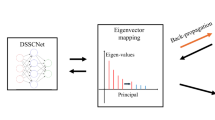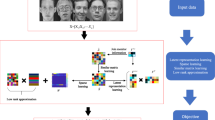Abstract
The robustness to outliers, noises, and corruptions has been paid more attention recently to increase the performance in linear feature extraction and image classification. As one of the most effective subspace learning methods, low-rank representation (LRR) can improve the robustness of an algorithm by exploring the global representative structure information among the samples. However, the traditional LRR cannot project the training samples into low-dimensional subspace with supervised information. Thus, in this paper, we integrate the properties of LRR with supervised dimensionality reduction techniques to obtain optimal low-rank subspace and discriminative projection at the same time. To achieve this goal, we proposed a novel model named Discriminative Low-Rank Projection (DLRP). Furthermore, DLRP can break the limitation of the small class problem which means the number of projections is bound by the number of classes. Our model can be solved by alternatively linearized alternating direction method with adaptive penalty and the singular value decomposition. Besides, the analyses of differences between DLRP and previous related models are shown. Extensive experiments conducted on various contaminated databases have confirmed the superiority of the proposed method.







Similar content being viewed by others
References
Wang X, Xing H, Li Y, Hua Q, Dong C, Pedrycz W (2015) A study on relationship between generalization abilities and fuzziness of base classifiers in ensemble learning. IEEE Trans Fuzzy Syst 23(5):1638–1654
Wang X, Wang R, Xu C (2018) Discovering the relationship between generalization and uncertainty by incorporating complexity of classification. IEEE Trans Cybern 48(2):703–715
Donoho D (2000) High-dimensional data analysis: the curses and blessings of dimensionality. In: AMS conference on math challenges of the 21st century, pp 1–33
Wang R, Wang X, Kwong S, Xu C (2017) Incorporating diversity and informativeness in multiple-instance active learning. IEEE Trans Fuzzy Syst 25(6):1460–1475
Sirovich L, Kirby M (1987) Low-dimensional procedure for the characterization of human faces. J Opt Soc Am A 4(3):519–524
Turk M, Pentland A (1991) A eigenfaces for face detection/recognition. J Cognit Neurosci 3(1):71–86
Yi S, Lai Z, He Z, Cheung Y, Liu Y (2017) Joint sparse principal component analysis. Pattern Recognit 61:524–536
Ben X, Gong C, Zhang P, Yan R, Wu Q, Meng W (2019) Coupled bilinear discriminant projection for cross-view gait recognition. IEEE Trans Circuits Syst Video Technol. https://doi.org/10.1109/TCSVT.2019.2893736
Ye Q, Yang J, Liu F, Zhao C, Ye N, Yin T (2016) L1-norm distance linear discriminant analysis based on an effective iterative algorithm. IEEE Trans Circuits Syst Video Technol 28(1):114–129
Sun W, Xie S, Han N (2019) Robust discriminant analysis with adaptive locality preserving. Int J Mach Learn Cybern. https://doi.org/10.1007/s13042-018-00903-4
Zhang W, Kang P, Fang X, Teng L, Han N (2019) Joint sparse representation and locality preserving projection for feature extraction. Int J Mach Learn Cybern 10(7):1731–1745
Lu G-F, Wang Y, Zou J, Wang Z (2018) Matrix exponential based discriminant locality preserving projections for feature extraction. Neural Netw 97:127–136
Roweis S, Saul L (2000) Nonlinear dimensionality reduction by locally linear embedding. Sicence 290:2323–2326
Sun B, Zhang X, Li J, Mao X (2010) Feature fusion using locally linear embedding for classification. IEEE Trans Neural Networks Learn Syst 21(1):163–168
Pang Y, Zhang L, Liu Z (2005) Neighborhood preserving projections (NPP): a novel linear dimension reduction method. In: International conference on intelligent computing, pp 117–125
He X, Cai D, Yan S, Zhang H (2005) Neighborhood preserving embedding. In: IEEE international conference on computer vision, pp 1208–1213
Gui J, Sun Z, Jia W, Hu R, Lei Y, Ji S (2012) Discriminant sparse neighborhood preserving embedding for face recognition. Pattern Recognit 45(8):2884–2893
Liu Z, Lai Z, Ou W, Zhang K, Zheng R (2020) Structured optimal graph based sparse feature extraction for semi-supervised learning. Signal Process. https://doi.org/10.1016/j.sigpro.2020.107456
Xiao C, Ding C, Nie F, Huang H (2013) On the equivalent of low-rank linear regressions and linear discriminant analysis based regressions In: International conference on knowledge discovery and data mining, pp1124–1132
Torre F (2012) A least-squares framework for component analysis. IEEE Trans Pattern Anal Mach Intell 34(6):1041–1055
Strutz T (2010) Data fitting and uncertainty: a practical introduction to weighted least squares and beyond. Springer Vieweg and Teubner, Wiesbaden, Germany
Liu H, Ma Z, Han J, Chen Z, Zheng Z (2018) Regularized partial least squares for multi-label learning. Int J Mach Learn Cybern 9(2):335–346
Wold S, Ruhe H, Wold H, Dunn W (1984) The collinearity problem in linear regression. The partial least squares (PLS) approach to generalized inverses. SIAM J Sci Stat Comput 5(3):735–743
Darmstadt T (2017) A compact formulation for the l21 mixed-norm minimization problem. In: IEEE international conference on acoustics, speech and signal processing, pp 4730–4734
Lai Z, Mo D, Wong W, Xu Y, Miao D, Zhang D (2018) Robust discriminant regression for feature extraction. IEEE Trans Cybern 48(8):2472–2484
Wang S, Xie D, Chen F, Gao Q (2018) Dimensionality reduction by LPP-L21. IET Comput Vis 12(5):659–665
Zhao L, Sun Y, Hu Y, Yin B (2014) Robust face recognition based l21-norm sparse representation. In: International conference on digital home, pp 25–29
Gu Q, Li Z, Han J (2011) Joint feature selection and subspace learning. In: International joint conference on artificial intelligence, pp 1294–1299
Ji S, Tang L, Yu S, Ye J (2010) A shared-subspace learning framework for multi-label classification. ACM Trans Knowl Discov Data 4(2):1–29
Lai Z, Xu Y, Yang J, Shen L, Zhang D (2017) Rotational invariant dimensionality reduction algorithms. IEEE Trans Cybern 47(11):3733–3746
Ma Z, Nie F, Yang Y, Uijlings J, Sebe N, Hauptmann A (2012) Discriminating joint feature analysis for multimedia data understanding for multimedia data understanding. IEEE Trans Multimed 14(6):1662–1672
Ma Z, Yang Y, Sebe N, Zheng K, Hauptmann A (2013) Multimedia event detection using a classifier-specific intermediate representation. IEEE Trans Multimed 15(7):1628–1637
Yang Y, Shen H, Ma Z, Huang Z, Zhou X (2010) L2,1-norm regularized discriminative feature selection for unsupervised learning. In: International joint conference on artificial intelligence, pp 1589–1594
Cheng L, Yang M (2018) Graph regularized weighted low-rank representation for image clustering. In: Chinese control conference, pp 9051–9055
Li S, Fu Y (2016) Learning robust and discriminative subspace with low-rank constraints. IEEE Trans Neural Networks Learn Syst 27(11):2160–2173
Liu Z, Wang X, Pu J, Wang L, Zhang L (2017) Nonnegative low-rank representation based manifold embedding for semi-supervised learning. Knowl Based Syst 136:121–129
Wen J, Fang X, Xu Y, Tian C, Fei L (2018) Low-rank representation with adaptive graph regularization. Neural Netw 108:83–96
Wong W, Lai Z, Wen J, Fang X, Lu Y (2017) Low rank embedding for robust feature extraction. IEEE Trans Image Process 26(6):2905–2917
Yin M, Gao J, Lin Z (2016) Laplacian regularized low-rank representation and its applications. IEEE Trans Pattern Anal Mach Intell 38(3):504–517
Candes E, Li X, Ma Y, Wright J (2011) Robust principal component analysis? J ACM 58(3):1–39
Liu G, Lin Z, Yan S, Sun J, Yu Y, Ma Y (2013) Robust recovery of subspace structures by low-rank representation. IEEE Trans Pattern Anal Mach Intell 35(1):171–184
Chen J, Yang J (2014) Robust subspace segmentation via low-rank representation. IEEE Trans Cybern 44(8):1432–1445
Li P, Yu J, Wang M, Zhang L, Cai D, Li X (2017) Constrained low-rank learning using least squares-based regularization. IEEE Trans Cybern 47(12):4250–4262
Zhuang L, Gao S, Tang J, Wang J, Lin Z, Ma Y (2015) Constructing a non-negative low rank and sparse graph with data-adaptive features. IEEE Trans Image Process 24(11):3717–3728
Liu G, Yan S (2011) Latent low-rank representation for subspace segmentation and feature extraction. In: International conference on computer vision, pp 1615–1622
Fang X, Han N, Wu J, Xu Y, Yang J, Wong W, Li X (2018) Approximate low-rank projection learning for feature extraction. IEEE Trans Neural Netw Learn Syst 29(11):5228–5241
Liu Y, Pados D (2016) Compressed-sensed-domain l1-PCA video surveillance. IEEE Trans Multimed 18(3):351–363
Wang Z, Xie X (2010) An efficient face recognition algorithm based on robust principal component analysis. In: International conference on internet multimedia computing and service, pp 99–102
Umap P, Chaudhari K (2015) Singing voice separation from polyphonic music accompanient using compositional model. Int J Adv Res Electr Instrum Eng 4:541–546
Zhou P, Lin Z, Zhang C (2015) Integrated low-rank-based discriminative feature learning for recognition. IEEE Trans Neural Networks Learn Syst 27(5):1080–1093
Lin Z, Liu R, Su Z (2011) Linearized alternating direction method with adaptive penalty for low-rank representation. In: Proceedings of 25th annual conference on neural information processing systems, pp 1–9
Yang J, Yin W, Zhang Y, Wang Y (2009) A fast algorithm for edge-preserving variational multichannel image restoration. SIAM J Sci Stat Comput 2(2):569–592
Cai J, Candes E, Shen Z (2010) A singular value thresholding algorithm for matrix completion. SIAM J Optim 20(4):1956–1982
Martinez A (1998) The AR face database. Cvc technical report, 24
Phillips P, Moon H, Rizvi S, Rauss P (2000) The FERET evaluation methodology for face-recognition algorithms. IEEE Trans Pattern Anal Mach Intell 22(10):1090–1104
Georghiades S, Belhumeur P, Kriegman D (2001) From few to many: Illumination cone models for face recognition under variable lighting and pose. IEEE Trans Pattern Anal Mach Intell 23(6):643–660
Learned-miller E, Huang G, Mattar M, Berg T (2007) Labeled faces in the wild : a database for studying face recognition in unconstrained environments. Technical Report
Wen Y, Zhang K, Li Z, Qiao Y (2016) A discriminative feature learning approach for deep face recognition. In: European conference on computer vision, pp 499–515
Acknowledgements
This work was supported by the Natural Science Foundation of China (Grant Nos. 61976145, 61802267, 61732011), and in part by the Shenzhen Municipal Science and Technology Innovation Council under (Grant Nos. JCYJ20180305124834854, JCYJ20160429182058044), and in part by the Natural Science Foundation of Guangdong Province (Grant No. 2017A030313367).
Author information
Authors and Affiliations
Corresponding author
Additional information
Publisher's Note
Springer Nature remains neutral with regard to jurisdictional claims in published maps and institutional affiliations.
Rights and permissions
About this article
Cite this article
Lai, Z., Bao, J., Kong, H. et al. Discriminative low-rank projection for robust subspace learning. Int. J. Mach. Learn. & Cyber. 11, 2247–2260 (2020). https://doi.org/10.1007/s13042-020-01113-7
Received:
Accepted:
Published:
Issue Date:
DOI: https://doi.org/10.1007/s13042-020-01113-7




